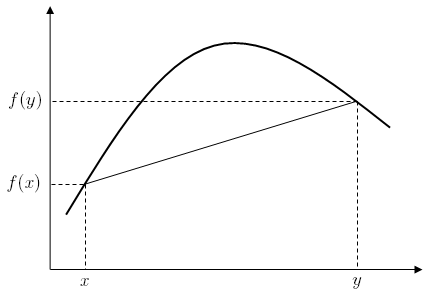Concave function
In mathematics, a concave function is one for which the value at any convex combination of elements in the domain is greater than or equal to the convex combination of the values at the endpoints. Equivalently, a concave function is any function for which the hypograph is convex. The class of concave functions is in a sense the opposite of the class of a convex functions. A concave function is also synonymously called concave downwards, concave down, convex upwards, convex cap, or upper convex.
Definition
A real-valued function on an interval (or, more generally, a convex set in vector space) is said to be concave if, for any and in the interval and for any ,[1]
A function is called strictly concave if
for any and .
For a function , this second definition merely states that for every strictly between and , the point on the graph of is above the straight line joining the points and .
A function is quasiconcave if the upper contour sets of the function are convex sets.[2]
Properties

Functions of a single variable
- A
- Points where concavity changes (between concave and convex) are inflection points.[5]
- If f is twice-negativethen f is strictly concave, but the converse is not true, as shown by f(x) = −x4.
- If f is concave and differentiable, then it is bounded above by its first-order Taylor approximation:[2]
- A Lebesgue measurable function on an interval C is concave if and only ifit is midpoint concave, that is, for any x and y in C
- If a function f is concave, and f(0) ≥ 0, then f is subadditive on . Proof:
- Since f is concave and 1 ≥ t ≥ 0, letting y = 0 we have
- For :
- Since f is concave and 1 ≥ t ≥ 0, letting y = 0 we have
Functions of n variables
- A function f is concave over a convex set if and only if the function −f is a convex function over the set.
- The sum of two concave functions is itself concave and so is the pointwise minimum of two concave functions, i.e. the set of concave functions on a given domain form a semifield.
- Near a strict local maximumin the interior of the domain of a function, the function must be concave; as a partial converse, if the derivative of a strictly concave function is zero at some point, then that point is a local maximum.
- Any global maximum. A strictly concave function will have at most one global maximum.
Examples
- The functions and are concave on their domains, as their second derivatives and are always negative.
- The logarithm function is concave on its domain , as its derivative is a strictly decreasing function.
- Any affine functionis both concave and convex, but neither strictly-concave nor strictly-convex.
- The sinefunction is concave on the interval .
- The function , where is the nonnegative-definite matrix B, is concave.[6]
Applications
- Rays bending in the computation of radiowave attenuation in the atmosphere involve concave functions.
- In choice under uncertainty, cardinal utility functions of risk aversedecision makers are concave.
- In microeconomic theory, production functions are usually assumed to be concave over some or all of their domains, resulting in diminishing returns to input factors.[7]
See also
- Concave polygon
- Jensen's inequality
- Logarithmically concave function
- Quasiconcave function
- Concavification
References
- ISBN 978-1-58488-640-2.
- ^ OCLC 24847759.
- ^ Rudin, Walter (1976). Analysis. p. 101.
- ISSN 0022-2305.
- )
- S2CID 5491763.
- ISBN 978-1-78499-148-7.
Further References
- Crouzeix, J.-P. (2008). "Quasi-concavity". In Durlauf, Steven N.; Blume, Lawrence E (eds.). The New Palgrave Dictionary of Economics (Second ed.). Palgrave Macmillan. pp. 815–816. ISBN 978-0-333-78676-5.
- Rao, Singiresu S. (2009). Engineering Optimization: Theory and Practice. John Wiley and Sons. p. 779. ISBN 978-0-470-18352-6.




![{\displaystyle \alpha \in [0,1]}](https://wikimedia.org/api/rest_v1/media/math/render/svg/daf3c62599ea71319c85f715c9e590d2bab2d036)











![{\displaystyle f(y)\leq f(x)+f'(x)[y-x]}](https://wikimedia.org/api/rest_v1/media/math/render/svg/ad4b94b94e56ebbdad4a9badaa4412142b032c08)













![{\displaystyle [0,\pi ]}](https://wikimedia.org/api/rest_v1/media/math/render/svg/3e2a912eda6ef1afe46a81b518fe9da64a832751)

